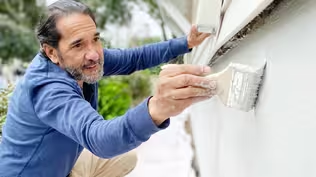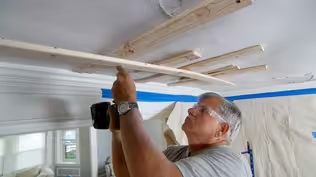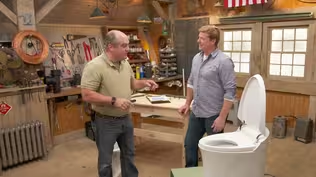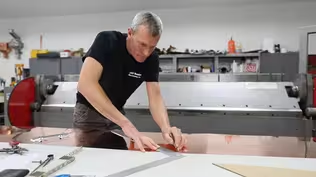
E17 | First Period Gambrel | Prep-Work
Season 44 Episode 17 | 23m 42sVideo has Closed Captions
A plan is devised to raise the timber frame in the ell. A book from 1826 is found.
Excavation has begun for the foundation for the two-story addition off the opposite side of the ell. A post and beam system supports the house so the existing foundation can be removed to open the old basement up to the new. A plan is devised to raise the timber frame in the ell. An old cistern uncovered under the ell is examined. Drainage issues are addressed. A book from 1826 found during demo.
Problems playing video? | Closed Captioning Feedback
Problems playing video? | Closed Captioning Feedback
Funding for THIS OLD HOUSE is provided by The Home Depot and Renewal By Andersen.

E17 | First Period Gambrel | Prep-Work
Season 44 Episode 17 | 23m 42sVideo has Closed Captions
Excavation has begun for the foundation for the two-story addition off the opposite side of the ell. A post and beam system supports the house so the existing foundation can be removed to open the old basement up to the new. A plan is devised to raise the timber frame in the ell. An old cistern uncovered under the ell is examined. Drainage issues are addressed. A book from 1826 found during demo.
Problems playing video? | Closed Captioning Feedback
How to Watch This Old House
This Old House is available to stream on pbs.org and the free PBS App, available on iPhone, Apple TV, Android TV, Android smartphones, Amazon Fire TV, Amazon Fire Tablet, Roku, Samsung Smart TV, and Vizio.

This Old House Insider Newsletter
Get This Old House exclusive stories, tips, and behind-the-scenes information delivered right to your inbox every month.Providing Support for PBS.org
Learn Moreabout PBS online sponsorshipKevin: Today on "This Old House"... Charlie: It's gonna take pressure off it so we can pull the foundation out.
Kevin: Oh.
There it goes.
Arron: I see marriage marks, and that tells me the original builder was scribing this building together.
Richard: And in 1720, this would have been our project's state-of-the-art water supply.
♪♪ [ Grunting ] ♪♪ Man: Ahh.
That's it.
♪♪ ♪♪ ♪♪ Kevin: Hi, there.
I'm Kevin O'Connor.
And welcome back to "This Old House" and to our project here in Ipswich, Massachusetts.
Last time we were here, demolition began, and it started up here with this gambrel -- the original part of the house dating back to 1720 -- demolition that will try to save as much as we can.
And then it continued through the connecting ell all the way back here, and you can see there's gonna be a new addition put off the back.
The excavation work is well under way for the new foundation, something Charlie has been working on for the past couple days.
Hey, Charlie.
Charlie: Hey, Kevin.
Kevin: A lot of industry going on down here.
Charlie: Yeah, it's a little different than last time.
Kevin: I'd say.
So, uh, give me the lay of the land.
Addition back here?
Charlie: Addition really all above us.
This is new basement space all the way to about -- to this line right here.
Kevin: Yeah.
Charlie: That's two-car garage, really, level with the first floor.
Kevin: Gotcha.
Garage with bedroom above it.
And sort of like a mudroom finished space above this basement here?
Charlie: That's right.
Kevin: Alright.
Charlie: We thought we were gonna be able to save the foundation.
Looks great on the inside.
Not even close on the outside.
Look at this.
Just falls right out.
Kevin: Oh, yeah.
Not much holding that up.
Charlie: Not much holding it.
Kevin: Ay yi yi.
That's not good.
Charlie: We could have saved it by doing a one-sided pour here, but that really gives me complications around the other side.
So what we're gonna do is we're gonna put a beam in above this cistern you see in front of you.
Kevin: Wait, wait.
Above it?
So this is staying?
Charlie: This is staying.
The homeowners love it, and they want to keep it exposed in the basement.
Kevin: Alright.
That's kind of cool.
Charlie: So we're gonna support above it.
Why we have a post around here.
But all of this foundation will be gone, and you can see into the old basement.
Kevin: Wow!
And I presume that all of this industry here is to support the house while that happens?
Charlie: That's right.
We put structural lumber through the house about 7, 8 feet to the inside, and we actually duplicated the same system with the hydraulic jacks on the inside.
Kevin: So you built kind of like a little bridge over this existing foundation and you're resting the house on the bridge?
Charlie: That's right, and we don't even have to jack it up much.
We just really want to take pressure of it so we can pull this foundation out.
Kevin: So what's next?
This is coming down?
Charlie: Next is me and you taking this out.
Kevin: Well, at least the digging looks easy.
Charlie: Not bad.
♪♪ Alright.
Let's get this one together.
Kevin: Oh, yeah.
Charlie: Ready?
Let it go.
♪♪ ♪♪ Kevin: Check that out, Charlie, huh?
That is pretty cool-looking.
Charlie: Yeah.
Kevin: It's like a big honey jar.
That is worth saving.
Charlie: It sure is.
♪♪ Tom: Arron, how you doing?
Arron: Good.
How are you?
Tom: I'm well.
So, tell me a little bit about you and what you do and your background.
Arron: Well, I'm a timber framer, and I focus in on historic buildings.
Tom: Yeah.
Arron: And we work all over New England, and we do church steeples, barns, and residential work like this.
Tom: So a lot of restoration.
Arron: Yep.
Heavy timber framing.
They don't call us until it's really rotten.
Tom: [ Laughs ] Cool.
What about this house that really brings your interest?
Arron: Well, the first thing is it's got an original overhang.
Tom: Really?
Arron: And we don't usually see overhangs on these early buildings.
Tom: That's true.
Arron: And that struck my interest right away.
Tom: Right.
A lot of these Capes that we see built in the '40s and the '50s, they had no overhang at all, and you're right.
Now that I see it... Arron: Yeah.
Tom: ...it is kind of unusual for that.
So let's go inside and take a look.
Alright.
So, this doorway that we're coming through is actually the original back wall of the house.
I can tell by the sheathing that was on here.
But they obviously removed the sheathing here.
They probably used that wood maybe when they built the ell at a later time.
But I can also see the diagonal bracing and the corner post here that says the back wall and signs of the old overhang.
Arron: Oh, yeah.
Yeah.
Tom: So what do you see?
Arron: Well, I see white oak, first of all, which lends itself to 1720 because they cut the white oak in this area really, really early.
But I also see a scribe rule timber frame.
And I can tell that because there are marriage marks.
And that tells me the original builder was scribing this building together.
So, marriage marks marry two timbers together.
They only go in this one place in the whole frame.
Tom: Yeah, so you want to make sure you use the right piece.
If you took that piece and tried to use it on the other corner, it's not gonna fit.
Arron: So we see a marriage mark right here that has a level line and then the arch, the actual half-circle.
Tom: Right.
Arron: You see its marriage mark here and on here.
So you got stud, brace, stud.
And that may indicate east.
This is the east wall of this building.
And this is kind of like sunrise.
Tom: Oh, yeah.
Arron: And then what's really interesting down here is I see a level line.
It has a straight line across and then an "X" through it, which is the original builder's mark for a reference point of level so they could build it level and plumb.
That's a great mark to see.
Tom: That's right.
It's all about level, plumb, and square.
Arron: Yeah, and the other thing I see is we've got this "L" connection right here, a little mortise and tenon joint here, then the tie beams offset away from the house.
This wouldn't have been how they would have done it originally, so this tells me that this "L" came on maybe a year later, maybe 10 years later.
It's hard to tell.
But one of the other indications that shows you that it was added later is the original sheathing that is all beveled.
Tom: Yeah, you can see that it's hand-done with a chisel right down here.
And really -- You can see it really good down here.
Arron: They overlapped this sheathing onto the existing sheathing.
That's not how they would have done it if this "L" was original.
Tom: Exactly.
Let's take a look upstairs.
Arron: Okay.
Sounds good.
Alright.
This is where the chimney used to be.
Tom: Right.
So we're right behind the front stairway.
Now, the front stairway wasn't original to the house.
But a lot of people don't know that the old Yankees would put a chimney in the center of the building because it's a lot more efficient.
It drafts better, but it also generates heat in the evening after the day's use of the fireplaces.
Arron: This timber frame is designed around that center chimney.
Tom: Absolutely.
Arron: And I can tell that because of the way this joinery is coming together.
We're looking at the gambrel roof framing right here.
Tom: Yeah.
Arron: That principal rafter coming up -- that's the steep-pitch rafter.
Tom: Right.
Right.
Arron: The purlins going across.
And the vertical sheathing.
Tom: Right.
Arron: And that makes the roof plane of the gambrel.
That's all original.
And then it changes pitch at the top of the gambrel as this tie beam connects the two sides of the house.
Tom: Right.
Arron: Then a short rafter goes right off the tie beam and goes up to the peak.
Tom: Right.
Arron: And you can tell that this is all original.
First of all, it's really super tight, doing really well.
But there's that marriage mark again.
That's a number "3" with a flag.
Tom: Yeah.
Arron: Number "3" with a flag.
That's that little mark off the right side here.
Tom: Here, and then you get the same thing up there.
Arron: And you see the same mark on the rafter.
So this is tie beam 3 going to rafter 3 in bent 3.
Tom: Right.
So these are the structural members, and the purlin is actually supporting the boards, because you'd think of the boards as going this direction, but they would stand them up and go that -- That's why you need the purlin.
Arron: Yeah.
Tom: Yeah, it's pretty cool stuff.
Arron: I just really like seeing how tight the joinery is 'cause it's 1720.
Tom: Yeah, the house really hasn't settled much at all on this part, but let's take a look at the ell.
There's a little bit of movement in there.
Arron: Okay.
Sounds good.
Tom: I see a lot going on here.
I mean, I see -- If I look at this frame, I see there's at least four, maybe five different iterations over the years that have gone on with this.
Arron: Yep, the first ell is this section right here.
Tom: Right.
Arron: Could've gone on at 1721.
Could've been 1725.
Because it's all hand-hewn.
The second iteration emulated that first one.
They used the same rafter-heel connection.
Tom: Yep.
Arron: But then the third iteration, they change completely into stick framing.
And then this whole second floor is the fourth iteration.
Tom: Right.
If you look down the end of the gable down there, you can see under that window there's a rafter that runs from that outside wall... Arron: Yep.
Tom: ...up to this wall right here.
This is a ridge beam that actually held a shed roof that went down.
Arron: You can see the mortise for that shed rafter.
Tom: Right.
So, now the homeowner wants the ceiling height in the kitchen, which is going to be down here, higher.
Have you got a plan?
Arron: Yeah.
I thought originally we were gonna lift up this original ell as a single building and then fix everything and elevate and put a post foot on each of the posts.
But I think we'll take it apart peacefully, fix everything on the bench, and then hand it back to you guys to put it where you want to put it.
Tom: I like the idea that you're gonna take it apart, you're gonna save as much of it as you can, and we'll throw away the junk.
Arron: There's a lot to save here.
I think it's worthwhile.
Tom: I agree.
I love these old houses.
Arron: I do, too.
♪♪ Richard: What I love about these old houses is to imagine how those early settlers dealt with the utilities, those things we take for granted.
You know, like, how do they heat the building or how do they get potable fresh water into the building?
This week, we discovered a really cool artifact, so we called in the experts.
Suzanne Cherau.
You are a historical archaeologist.
How are you?
Suzanne: Hi, Richard.
I'm good.
Yeah.
I'm checking out this feature.
Richard: Yeah.
Tell us what you do.
Tell us what you do.
Suzanne: Yeah, so, I'm a historic archaeologist.
I've been working in New England for over 30 years.
We work on old house sites just like this.
Most of the time, there's nothing left of the house.
It's just the ruins, just the foundations.
But we do find artifacts like this.
Richard: Take us through.
We're looking at a cistern, right?
Suzanne: Yeah, I believe we're looking at a cistern.
Definitely hand-made brick, so telling us it was built in the 18th century.
Richard: A cistern just collects water, correct?
Suzanne: It just collects water, so it wasn't a well.
Richard: So they might have had this to collect rainwater and store some water.
Suzanne: Definitely.
Maybe for drinking, but definitely to wash, do laundry, you know, household chores, feed the animals, you know, that sort of thing.
Richard: So take us through the cistern.
How do you build this thing?
Suzanne: This one was two bricks thick.
And it looks like here -- the portion that was underground here.
You know, there's definitely charring and burning on the outside of the bricks, which tells us that they look like they were reused from, like, a chimney or a fireplace.
And the fact that there is no what we call builder's trench, which would have been darker soil, would indicate to us that it was constructed from the opposite side and that these bricks were placed, put in place against either fill or natural subsoil.
And this was definitely mortared all the way down to the bottom.
There's a -- Where I've drawn this thin line just to kind of delineate between the natural subsoil.
That's a very hard-packed, you know, kind of glacial, granular, sandy soil.
And then above that, it looks like they put a very thin course of parging, you know, to make it waterproof at the bottom to prepare the bottom surface.
It sat right on the natural subsoil.
Richard: And there's a big opening at the top.
Suzanne: Right.
That would have been for a trapdoor, say, in the porch.
And either, you know, just manually put a bucket down to collect the water that they needed for whatever chore.
Richard: Yeah.
Suzanne: Or at some point had a crank.
Richard: Yeah, so there would have been a lot of things going on in this little small yard, right?
You would've had a well.
You would've had a privy or two.
A vegetable garden.
You got the cistern.
Suzanne: Yeah.
Richard: Some outbuildings.
There's a lot of things to place.
Suzanne: And to spatially arrange everything so that it worked and hopefully didn't make them sick.
You know, bacteria wasn't, you know, well-known back then, but they still kind of knew what made them sick and what didn't.
Richard: It must be a really fun job, actually, to imagine how people lived.
Suzanne: Yeah, it is.
It is.
Richard: Can we look inside?
Suzanne: Definitely!
Richard: Alright.
Suzanne: Okay.
So, we would call this a bottle-shaped cistern.
Richard: Aptly named.
Suzanne: Aptly named, yes.
Primarily because of the shape at the top.
And we would have this opening that would have had, you know, a cover.
Richard: Okay.
Suzanne: So that's the name.
Richard: I've got a camera and a light.
Let's see what it looks like down inside there.
And I want you to hold this.
You can...see what we got.
I'll tell you one thing.
I'm amazed.
It just looks like it's still almost brand-new.
Suzanne: Right.
There's definitely parging in the inside, just like we thought there'd be, for the waterproofing.
Richard: Let's see what we got down on the bottom.
So it's about 7 feet deep.
A little bit of debris at the bottom, but that would be expected after all this time.
It's actually amazing, the kind of shape it's in.
It's crazy.
Suzanne: It was well made.
Richard: It was.
Suzanne: Definitely well made.
Richard: And I see the evidence of a lead pipe right here.
Suzanne: Yep.
So, that would have gone inside the basement of the house.
Richard: So as the water level came up, it would have forced water over the top of that, what they call a crown, and it would allow you to draw water inside.
Suzanne: Yeah.
Spigot inside.
Richard: It looks like it went in yesterday.
Well, thank you, Suzanne.
It was great having a resident expert available.
Suzanne: Well, thank you, Richard, for inviting me.
It was a wonderful way to spend my afternoon.
Richard: [ Laughs ] ♪♪ Tom: Hey.
Charlie: So what do you think?
Tom: Uh, I think it's going pretty good, but I talked to Arron, and I think he and I agree that instead of raising this all, he wants to take it apart piece by piece and save as much as he can 'cause he thinks it'd be safer and more efficient.
I think Bill and Helen will be really happy with that.
Charlie: And you know what?
That makes my day.
Because last week they decided to save all the old roof sheathing and rafters and use it as a decorative trim on the newly framed roof.
Because that ridge is coming down 7 seven feet.
And when these beams get pushed up about 14 to 18 inches, you're gonna look right through that to the new ceiling.
Tom: That's a big job.
We'd be lucky to save 50% of them.
Charlie: Yeah, but it'll be worth it.
Tom: I agree.
Charlie: And they are so passionate about saving these boards.
They really want us to do everything we can do.
Tom: I don't blame them, but, you know, it is a lot of work to save this old wood.
But I agree with it.
It should be saved.
Charlie: Yeah, so, we're gonna start taking them off, but we have to be real careful even from taking them off and even storing them.
Tom: It's gonna really make a difference.
Charlie: Oh, it's gonna be beautiful.
♪♪ ♪♪ ♪♪ ♪♪ ♪♪ Kevin: We've got a drainage problem, which means we might have a rot problem.
We won't know until these guys figure it out.
Mark, Charlie.
What's going on?
Mark: Hey, Kevin.
Charlie: Well, Kevin, as you can see, the street's higher than the house.
Kevin: Never good.
Charlie: Not the best way to build.
This side is about 4 inches below grade on the street.
The other side is about 10-plus.
Kevin: So anything that rains on that street running off and down into our house.
Mark: Comes right down.
We're gonna probably take five, six rows of clapboards off, investigate, do any repairs.
Kevin: And there's no going into the basement or crawl space over here because we don't have one in this corner, do we?
Charlie: Doesn't exist.
Kevin: Alright.
So we just got to pull away and investigate?
Charlie: Gonna pull some claps off.
Alright, Mark, this row right here, we're gonna start setting the nails through the claps so we can pull the row behind it.
Mark: Sounds good.
Charlie: And we're not actually saving any of these.
These are not original claps, so we don't have to worry about saving them.
And this will preserve the rest of the rows above.
Alright.
We think this is loose enough to get this row out.
Once you get that first one off, Mark, we can just go right behind these other ones.
Mark: Okay.
Gotcha.
Kevin: Exploratory demo, right?
This is what we got to do to find out what's going on behind all this stuff.
Charlie: That's right, Kevin.
That's right.
Alright.
Perfect.
Mark: Ready?
Yeah.
Now go below it?
Charlie: Yeah.
Right out to the corner, be done.
Ready?
Mark: Yeah.
At least these are back-primed, Charlie.
Charlie: Yeah.
Mark: That's one.
Charlie: Alright.
Let's just get this last row.
Kevin: Tar paper tells you something, right, Charlie?
Charlie: Somebody was here not too long ago.
Let's lift it up and see what we have here.
It's definitely old boards, that's for sure.
Mark: Look at the rot down here, Charlie.
Charlie: Oh, yeah.
Yep.
Kevin: Yep.
All the way across.
It's eating out right there.
Charlie: There's some masonry here, for sure, that somebody poured.
I say we pull up at least just one board and see what we find.
Mark: Alright.
Charlie: Get under it.
Oh, yeah.
Yeah.
Go down further.
I'll hold it out.
Mark: Get under that, Kev?
Kevin: I'll come right over it.
There she is.
Oh, look at this.
Charlie.
Charlie: Not even a sill.
Kevin: No sill.
Charlie: Studs right to the concrete.
The studs look original, but this concrete.
I don't know, Mark.
What do you think?
20 years old anyway?
Mark: Yeah, that's got to be 20 years anyway.
Charlie: Yeah, so my bet is that there was a sill.
It was completely rotted.
Whoever did these repairs took out the rot, poured some concrete right under the existing studs.
Kevin: And this is all rotted away right there, Charlie.
So what's the fix for that?
Charlie: Believe it or not, the fix shouldn't be that bad.
We're gonna get in some pressure-treated.
We're gonna probably go up at least two high -- two 2-bys high.
Cut the rot out of the existing 2x4s in the wall.
But we're only gonna do sections at a time, so it's not like we have to carry this whole side of the house and put some real weight on it.
And if we have to, we're gonna pull some more boards up and sister beside the existing studs some new 2-bys pressure-treated.
And then, you know, once that's all down, you know, patch it back in with boards.
Kevin: Maybe solve this drainage problem once and for all?
Charlie: Once and for all.
Original plan had a stone wall in place of this fence.
Would've been expensive.
Ran past the house about 12 feet.
We have a better solution that's gonna be cheaper.
Kevin: Okay.
So let's see.
What are we looking at here?
Bottom of the house here and the road all the way up here?
Charlie: Yeah, the architect drew this up, not knowing what we had below grade.
So, this is the studded wall that we have, and we exposed the bottom of the studs and saw all the rot.
And this is the boards that were on the outside of the house.
So, since this is the street grade, our new grade is gonna be higher than the street, so it will actually drain back towards that.
Kevin: And then what are we gonna do?
Once we fix the rotted studs, what are you gonna do to protect this wall?
Charlie: We'll put some pressure-treated plywood in against the new framing, waterproofing, a drainage mat.
And then to match the existing house, which is a granite on the foundation, Mark has this.
Kevin: Wait.
What?
This here?
This is gonna be the veneer?
Charlie: This is gonna be the veneer against the house.
Kevin: Oh!
This here you're saying is granite?
Mark: Well, this is why I love these water-management problems, because we can use today's technology and the drainage mat and then the waterproofing membrane.
But the twofold here is this granite.
We get the aesthetic value out of it, but we also get the toughest protection we can have against the water.
Kevin: Sheds the water, never rots, and it's gonna look great.
Mark: Exactly.
Charlie: And we're gonna support it with a piece of stainless-steel angle that will be bolted to the house, and the granite will sit right on top, never go anywhere.
Kevin: And if this is our new grade, Charlie, what's all underneath here?
Charlie: We're gonna put all new stone in down below grade.
All the way from the other side of the house, we're gonna have a drainage pipe which will go to a 2,000-gallon tank we have.
Kevin: Which will be in the front yard.
I like it.
Alright.
Thank you, Mark.
We should probably report this to Bill, the homeowner.
Charlie: Yeah, let's tell him.
Kevin: Alright.
I guess that's good news, right?
Charlie: Eh, it's good news.
Kevin: Alright, Bill, I think Mark and Charlie got a solution for the drainage problem, which is good.
Bill: Oh, good, good, 'cause we've been wondering about that.
Charlie: It's gonna save a lot of work on the landscape, and it's gonna be a great solution for waterproofing the side of the house.
Bill: Okay, yeah, because they were talking about building a retaining wall, which just didn't seem right for that corner.
Charlie: Yeah.
Not needed now.
But when we were demo'ing the ell, had a lot of the roof boards that we're saving for the inside of the new addition there on the roof line -- We were taking off the rafters, and we found something.
Bill: [ Gasps ] Charlie: It's a book on the American Revolution from 1826.
Bill: No!
Kevin: In the walls?
Bill: No!
Are you kidding me?!
Kevin: So, you had told us at one point that a Revolutionary War officer resided in your house.
Bill: Yes, who worked right under George Washington and was at Valley Forge and witnessed much of the Revolutionary War and wrote about it in his letters to his wife.
All of which have formed an important basis for history of the Revolutionary War.
Wow!
Oh, my God!
Charlie: So a little night reading now for you.
Bill: Look at that!
"1826."
Kevin: And a name.
I can't quite make it out.
Jared Atwater.
Bill: Atwater, it looks like.
Yeah.
Kevin: Jared Atwater.
Another one here.
How about that?
Jared Atwater.
Bill: So, where did you find these?
Charlie: Right up where -- The rafters that we're saving.
Just sitting right in there.
One of the guys found it.
Bill: Look at this.
This is so exciting.
Kevin: Well, you've got some more research work that you have to do now.
Bill: Yeah, I know.
Kevin: But enjoy it.
Tell us what you figure out.
Bill: Thank you.
Kevin: And if we find out anything else, we'll let you know.
But we will continue with the work, and so that is a wrap for now.
And next week, Charlie, we are taking down that timber frame?
Charlie: We are.
Kevin: Piece by piece.
Kevin: Arron's coming back.
Our expert's gonna help us.
So, until then, I'm Kevin O'Connor... Charlie: I'm Charlie Silva.
Kevin: ...for "This Old House" here in Ipswich, Massachusetts.
Check it out.
You happy?
Bill: I can't believe it.
Charlie: There is a late fee for the library.
Bill: [ Laughs ] I'll gladly pay it.
Kevin: Next time on "This Old House"... Mark: I'm investigating whether a revolutionary fireplace designed from the 1790s is gonna work on our project.
Jenn: This backyard is filled with invasives, and we're gonna find out today if there's a plan to get rid of them.
Woman: So, the problem with all invasive plants is that they outcompete the native plants, which are so important for the local wildlife.
Tom: And we're saving as many of these old timbers as we can to reuse in this old house.


- Home and How To

Hit the road in a classic car for a tour through Great Britain with two antiques experts.












Support for PBS provided by:
Funding for THIS OLD HOUSE is provided by The Home Depot and Renewal By Andersen.






